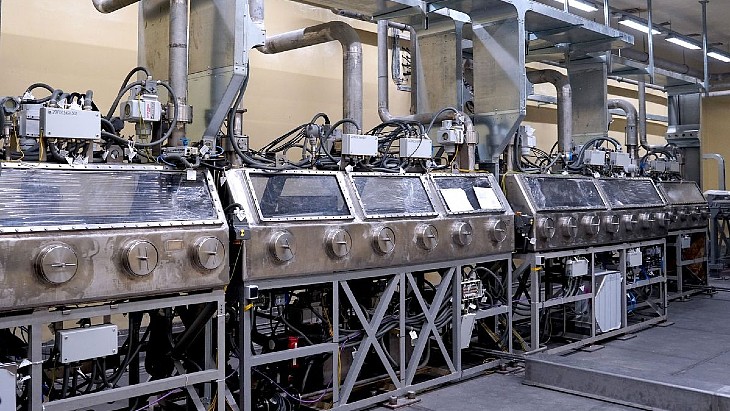The lead-cooled BREST-OD-300 reactor is part of Rosatom's Proryv, or Breakthrough, project to enable a closed nuclear fuel cycle. The 300 MWe unit will be the main facility of the Pilot Demonstration Energy Complex (PDEC) at the Siberian Chemical Combine site. The complex will demonstrate an on-site closed nuclear fuel cycle with a facility for the fabrication/re-fabrication of mixed uranium-plutonium nitride nuclear fuel, as well as a used fuel reprocessing facility.
Rosatom and its TVEL fuel division said that the licence gives the go-ahead for Siberian Chemical Combine to test the entire production process. It says that the fuel developed for the BREST-OD-300 reactor is a mixed dense nitride uranium-plutonium fuel (MNUP) based on depleted uranium - a by-product of uranium enrichment for nuclear reactors - and plutonium extracted from irradiated nuclear fuel.
The MNUP fuel cannot be produced using standard technology and equipment and the process needs to be as automated as possible because of the use of radioactive plutonium extracted from used nuclear fuel. According to Rosatom "four production lines will be used - a line for the carbothermal synthesis of mixed uranium and plutonium nitrides, a line for the production of fuel pellets, a fuel rod assembly line, as well as a production line for complete fuel cassettes. Currently, commissioning of installed equipment is under way on the production lines".
The fuel fabrication/refabrication unit is the first of the PDEC facilities to be commissioned, with all the works scheduled to be completed by the end of 2024. TVEL said that "at the next stage, after obtaining the appropriate permission from Rostechnadzor to handle plutonium" the equipment will be used to directly produce MNUP fuel.
At a ceremony to launch testing of equipment, held during the recent AtomExpo 2024 event, Rosatom Director General Alexei Likhachev said: "Everything at this facility is unique - the technology itself, each piece of equipment, its layout, and each production site is a solution to a technological problem that no one else in the world has ever taken on."
The plan is that the use of secondary products will expand the resource base of the nuclear power industry "multifold" and reduce the volumes of radioactive waste. In January the steel reactor base plate and the lower tier of the containment for the BEST-OD-300 was installed - the target is for it to start operation in 2026.
According to the World Nuclear Association information paper on fast neutron reactors, "the BREST fast neutron reactor, of 700 MWt, 300 MWe has lead as the primary coolant, at 540°C, and supercritical steam generators. It is inherently safe and uses a mixed uranium and plutonium nitride fuel... no weapons-grade plutonium can be produced, since there is no uranium blanket - all the breeding occurs in the core ... fuel cycle is quoted at 5-6 years with partial refuelling at about 10 months. The initial cores can comprise plutonium and used fuel - hence loaded with fission products, and radiologically 'hot'. Subsequently, any surplus plutonium, which is not in pure form, can be used as the cores of new reactors. Used fuel can be recycled indefinitely, with onsite facilities. The nitride fuel has been successfully tested in the BN-600 reactor to a burn-up of 7.4%".
Initial operation of the demonstration unit will be focused on performance and after 10 years or so it will be commercially oriented. The plan has been that if it is successful as a 300 MWe unit, a 1200 MWe (2800 MWt) version will follow - the BR-1200.






_63865.jpg)
_18570.jpg)
_16159.jpg)





